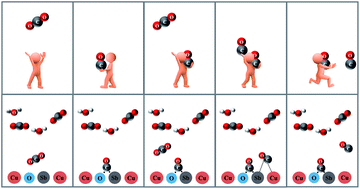Facile synthesis of an antimony-doped Cu/Cu2O catalyst with robust CO production in a broad range of potentials for CO2 electrochemical reduction†
Abstract
The electrocatalytic CO2 reduction reaction (CO2RR) on copper-based catalysts is a promising method to produce valuable chemicals, but its selectivity is much lower than expected largely due to insufficient research on the structure of new materials. Herein, the antimony-doped Cu/Cu2O (Cu/Cu2O–Sb) catalyst is developed for a highly selective CO2RR to CO. The synthesized Cu/Cu2O–Sb exhibits intensive suppression of hydrogen evolution, a low overpotential and high faradaic efficiency (FE) towards CO. The CO selectivity is as high as ∼95% with a partial current density of ∼6.3 mA cm−2 at −0.9 V and maintains over 90% in a broad range of potentials. DFT calculations reveal that the doping of antimony achieves the distinct activation of CO2 and suppression of hydrogen evolution. Meanwhile, the pre-adsorbed *CO significantly promotes the desorption of the neighboring *CO, which is the key for high selectivity of CO2RR to CO. This work will provide a new consideration for the origin of high selectivity during the CO2RR and pave the way toward design of highly selective CO2 reduction catalysts.



 Please wait while we load your content...
Please wait while we load your content...